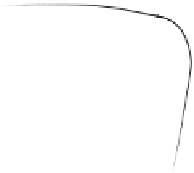Biomedical Engineering Reference
In-Depth Information
results from the two blocks on the table. The magnitude and the direction of the
forces are shown in the figure. Note that the table should support the contact force of
15 N, due to the weight of the two blocks on it.
Exercise 1.6
Consider Example 1.3. Now invert the position of the two blocks and
analyze the forces. Draw all the forces that act on each block and the contact force
on the table.
Exercise 1.7
Consider Example 1.3. Now place a third block which weighs 3 N
beneath block A. Draw all the forces that act on each block and the contact force on
the table.
Exercise 1.8
Consider a person seated with the leg vertically and the foot hanging,
as shown in the figure of Exercise 1.8. This person wears an exercise boot with a
weight attached to it. Consider that the sum of the mass of the leg with that of the
foot is 3.5 kg (35 N), that the mass of the boot is 1.35 kg (13.5 N), and that the mass
of the weight is 4.5 kg (45 N). Represent the forces that act on the leg and determine
the resultant of forces which must be compensated by the force acting on the knee
articulation (joint).
Example 1.3 and Exercises 1.6 and 1.7 have shown that the contact force on each
block is different, being always larger on the block which is on the bottom of the
structure. In any vertical structure, the contact force on a part near the bottom of
the structure is greater than the contact forces on a part near the top. This is the
reason why in both artificial (high buildings) and natural structures (spinal column)
the lower parts are larger than the higher parts in order to support larger contact
forces. For the same reason, the vertebrae of the human spinal column increase in
size continuously from top to bottom, as can be seen in
Fig. 7.6
.




























